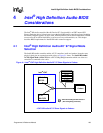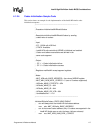
112 Programmer’s Reference Manual
Intel® High Definition Audio BIOS Considerations
4.1.2 Intel
®
High Definition Audio Codec Initialization
This section involves the programming interface on Intel® HD Audio codec link. Readers are
encouraged to read the relevant chapters of Intel® HD Audio Specification for information
regarding architecture overview, register interface, programming model and codec features and
requirements.
Intel® HD Audio allows flexible configurations of the inputs and outputs among its internal
functional units and between codec and external jacks. Each pair of pins in the codec is assigned to
an internal node in the codec, so the information related to the jack position, color coding, etc. is
mapped to the node that is internally assigned to the pins and wired to a jack. This information will
allow the audio driver to configure the audio codecs correctly.
After BIOS has determined the presence of Intel® HD Audio codec(s), it must follow the
programming sequence given in this section to update the codec with correct jack information
specific to the platform for Intel® HD Audio driver to retrieve and use later. If the codecs are not
initialized with this platform-specific information, the Intel® HD Audio driver will use the default
data in the codecs which may or may not match the pin/jack connections or jack locations of the
platform.
4.1.2.1 Intel
®
High Definition Audio Codec Architecture Introduction
The Intel® HD Audio Specification defines a modular codec architecture that is fully discoverable
and configurable by software. It provides for the construction and description of various codec
functions from a defined set of parameterized modules (building blocks, or Widgets). Each such
module and each collection of modules becomes a uniquely addressable Node, from which
software can read capability parameters and to which it can send control commands. The root node
is the top level node and always has a Node ID (NID) of 0. Each node contains information of the
next level of nodes below it, in a tree structure as shown in Figure 4-2.
For each Intel® HD Audio codec present, a unique Codec Address (CAd) is assigned to the codec
by hardware after reset during the codec link initialization and will be used for software to address
each codec. For instance, the codec connected to SDI0 (as indicated by AZBAR+0Eh[0]=1) has its
CAd=0, the codec connected to SDI1 (as indicated by AZBAR+0Eh[1]=1) has its CAd=1, and so
on, each node in a codec has its pre-defined, unique Node ID (NID). The CAd+NID combination is
used by a Verb to uniquely address a codec node.


















